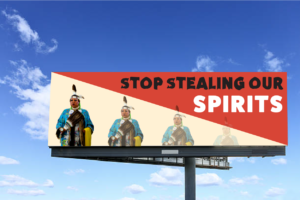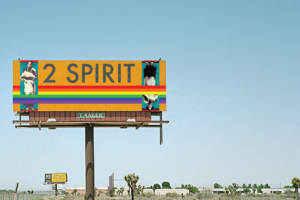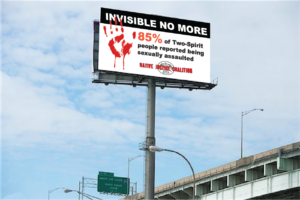Two-Spirit is a Pan-Indian umbrella term for American Indians who identify outside the male and female gender binary; who possess both masculine and female energy and exist within a third or fourth gender. Two-Spirits are a vital topic within our MMIW exhibit because they are also targeted, murdered, assaulted, and disappear at alarming rates like Indigenous women and girls. Currently, the epidemic mainly focuses on cis-women, with some variation including girls and Two-Spirits using hashtags like #MMIWG2S.
The name of my exhibit, STOP STEALING OUR SPIRITS, is referring to both the revered Two-Spirit people, as well as referencing how Two-Spirit people have historically been the backbone, or spirit, of a native community. The word stealing is intentional. Two-Spirit people are also a danger to themselves in that, the lack of acceptance and love for their gender, race, and sexuality cause them to have high rates of suicide. Those who are not murdering their bodies, but desecrating their souls are essentially stealing Two-Spirits’ spirit.
The issue currently is not getting the majority to care about MMIWG2S, but how do we advocate for people who the majority doesn’t know exist or refuse to validate. The most prominent tool I found for awareness building was billboards which only featured indigenous women and statistics that brought attention to them. However, I could not find one single Two-Spirit billboard, so I decided to create my own billboard designs. The goal of my billboards is to bring honor to Two-Spirit American Indians as well as attention to the violence against Two-Spirit American Indians. From a practical standpoint, a billboard on average in New Mexico costs $2,000 for the month, meaning 500,000 people will drive by a striking message. Further, the areas in which Indigenous women, girls, and Two-Spirits are being attacked are in desolate locations that require cars and highways.
*TO VIEW IMAGE IN HIGHER RESOLUTION RIGHT CLICK, OPEN IMAGE IN NEW TAB

STOP STEALING OUR SPIRITS
This billboard features a Two-Spirit American Indian from the eighth annual Two-Spirit Powwow in San Francisco. I appreciated their colorful and fearless style and wanted to put a modern face to American Indians who are often portrayed as frozen in time. The image gradually shrinks and becomes more opaque while in line with the red angle. I intentionally depicted a graph-like style to emphasize the drastic decrease in population size of Two-Spirit persons, as well as their treatment as numbers or bodies, not actual humans. The red is to reference the same red tone of the MMIW designs and the aggressive font is to demonstrate the violent nature of the crimes.

GENDER IS A COLONIAL CONSTRUCT
The yellow billboard features We'wha, a Zuni Two-Spirit from the 1880s that was a cultural ambassador for their people. I couldn’t find anything indicating We'wha choosing a specific pronoun so for the sake of remaining gender neutral I will refer to We'wha as “they.” We'wha was a popular figure among Washington elites after they befriended a white anthropologist, Matilda Coxe Stevenson, who studied Zuni life (Roscoe). We'wha demonstrated Zuni weaving to the public and was able to speak on behalf of their people to President Cleveland (Cherry). However, Stevenson and her D.C. friends were of no help when the Bureau of Indian Affairs and missionaries wiped out Zuni culture in New Mexico including Two-Spirit traditions. We'wha should still be remembered for their ability to courageously communicate their people's needs to legislators and share a piece of themselves.
I wanted to create a billboard that was more artistic and expressive than informative. I used a strong image of We'wha in both men’s and women’s clothing with a bold and pronounced font. Many of the Two-Spirit societies use the rainbow symbolism so I incorporated it to create a weaved-like pattern because Two-Spirit persons were known for being hunters and weavers. The image of We'wha is flipped to contrast against an idea of a binary. The reflective flip shows how they can be both genders, within a binary context, at the same time. I want this billboard’s message to convey the long existence of Two-Spirit American Indians and their strong existence today with a modern font and color palette. The hope is that drivers seeing this will not know what “2SPIRIT” means and want to look it up. This way their first interaction with understanding Two-Spirit identities is not with how they are violated.

INVISIBLE NO MORE
This billboard supposed to replicate the existing MMIW designs similar to ones I found Representative Deb Haaland of Laguna Pueblo holding. I included the same headline “INVISIBLE NO MORE” followed by a statistic specific to Two-Spirit people from the National Library of Medicine and National Institutes of Health. I also added the red bloody handprint which also is a common symbol used in MMIW activism. The Native Justice Coalition logo is featured because it is where I began most of my research among advocating for Two-Spirit lives. The sight particularly talked about resources for Two-spirit youth and healing circles with significant turnout for story sharing. The idea here is that viewers have seen the MMIW signs and billboards and link them to the one I’ve created, only this time it specifies Two-Spirit persons. I wanted to use my graphic design skills to create images that could be just as effective blown up on a billboard or in a legislator’s hands. It is also a nod to the activists who have been conducting this work for many years now.

TWO-SPIRIT = HUMAN
The final design I created is a modern version of a billboard, like a digital bus sign, that could be put in a city center. Digital activism is also cost-effective and the foot traffic allows people to stop or sit and actually pay attention to what they’re looking at. For the messaging, I wanted to have a basic definition for the general population to comprehend Two-Spirit persons’ gender and sexuality. I thought depicting persecution from a racial, gendered, and sexual standpoint might be too academic for all audiences to fully grasp Two-Spirit identity so I took a simpler approach. The font is both black and white to represent the binary as well as to equate the words “Two-spirit” and “Human.” I am intentionally signifying that Two-Spirit persons are human beings. Colonialism has deemed American Indians as violable because their culture has been eradicated due to symbolic annihilation therefore they are seen as insignificant as a people. In addition, they are dehumanized for rejecting western gender and sexuality, so the need to emphasize humanity to the viewer is crucial. Further, I hope viewers also see that all human beings are multifaceted themselves.
The definition chosen is based on the banner from the Standing Rock Two-Spirits. It reads: “We feel and express differently because we were blessed with 2 spirits. We are male and female. We are hay, bi, and straight...its a gift...a sacred station.” As time went on the banner changed straight to “transgender and lesbian” so for general audience purposes I changed the word to queer to avoid confusion with transgender definitions. I chose to include the triangle watercolor over basic solid coloring because the Standing Rock Two-Spirits were protesting the damage done to the Missouri River and other natural sources of water (Amor), hence watercolor. The Standing Rock Two-Spirits contributions feel significant to me because not only are these Two-Spirit folks advocating for themselves and their community but for all American Indians and non-Indian lives that would be affected by the Dakota Access Pipeline. They represent that Two-Spirits are not afraid to speak their minds and are leaders of their community.
Amor, Bani. “Queering the Environmental Movement.” Earth Island Journal, Earth Island Institute, 2018, www.earthisland.org/journal/index.php/magazine/entry/queering-the-environmental-movement/.
Friedler, Delilah. “At San Francisco’s Two-Spirit Powwow, Gender Diversity Is Sacred.” Mother Jones, 26 Feb. 2020, www.motherjones.com/media/2020/02/at-san-franciscos-two-spirit-powwow-gender-diversity-is-sacred/.
Hunt, Sarah. An Introduction to the Health of Two-Spirit People: Historical, Contemporary and Emergent Issues. National Collaborating Centre for Aboriginal Health, 2016, www.nccih.ca/docs/emerging/RPT-HealthTwoSpirit-Hunt-EN.pdf.
Katz, Jonathan N, and Neil Miller. “Out Of The Past.” PBS, Public Broadcasting Service, 1995, www.pbs.org/outofthepast/past/p2/1886.html.
Lehavot, Keren et al. “Abuse, mastery, and health among lesbian, bisexual, and two-spirit American Indian and Alaska Native women.” Cultural diversity & ethnic minority psychology vol. 15,3 (2009): 275-84. doi:10.1037/a0013458
Roscoe, Will. “We’wha and the Zuni Third Gender Role.” The Zuni Man-Woman, University of New Mexico Press, 1991, www.willsworld.org/zunibook/zunibook.html.
Scott Lauria Morgensen (2012) Theorising Gender, Sexuality and Settler Colonialism: An Introduction, Settler Colonial Studies, 2:2, 2-22, DOI: 10.1080/2201473X.2012.10648839
Williams, Walter L. “The ‘Two-Spirit’ People of Indigenous North Americans.” The Guardian, 11 Oct. 2010, www.theguardian.com/music/2010/oct/11/two-spirit-people-north-america.